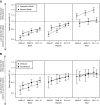Expanded Prospective Payment System and Use of and Outcomes with Home Dialysis by Race and Ethnicity in the United States
- PMID: 31320318
- PMCID: PMC6682814
- DOI: 10.2215/CJN.00290119
Expanded Prospective Payment System and Use of and Outcomes with Home Dialysis by Race and Ethnicity in the United States
Abstract
Background and objectives: We investigated whether the recent growth in home dialysis use was proportional among all racial/ethnic groups and also whether there were changes in racial/ethnic differences in home dialysis outcomes.
Design, setting, participants, & measurements: This observational cohort study of US Renal Data System patients initiating dialysis from 2005 to 2013 used logistic regression to estimate racial/ethnic differences in home dialysis initiation over time, and used competing risk models to assess temporal changes in racial/ethnic differences in home dialysis outcomes, specifically: (1) transfer to in-center hemodialysis (HD), (2) mortality, and (3) transplantation.
Results: Of the 523,526 patients initiating dialysis from 2005 to 2013, 55% were white, 28% black, 13% Hispanic, and 4% Asian. In the earliest era (2005-2007), 8.0% of white patients initiated dialysis with home modalities, as did a similar proportion of Asians (9.2%; adjusted odds ratio [aOR], 0.95; 95% confidence interval [95% CI], 0.86 to 1.05), whereas lower proportions of black [5.2%; aOR, 0.71; 95% CI, 0.66 to 0.76] and Hispanic (5.7%; aOR, 0.83; 95% CI, 0.86 to 0.93) patients did so. Over time, home dialysis use increased in all groups and racial/ethnic differences decreased (2011-2013: 10.6% of whites, 8.3% of blacks [aOR, 0.81; 95% CI, 0.77 to 0.85], 9.6% of Hispanics [aOR, 0.94; 95% CI, 0.86 to 1.00], 14.2% of Asians [aOR, 1.04; 95% CI, 0.86 to 1.12]). Compared with white patients, the risk of transferring to in-center HD was higher in blacks, similar in Hispanics, and lower in Asians; these differences remained stable over time. The mortality rate was lower for minority patients than for white patients; this difference increased over time. Transplantation rates were lower for blacks and similar for Hispanics and Asians; over time, the difference in transplantation rates between blacks and Hispanics versus whites increased.
Conclusions: From 2005 to 2013, as home dialysis use increased, racial/ethnic differences in initiating home dialysis narrowed, without worsening rates of death or transfer to in-center HD in minority patients, as compared with white patients.
Keywords: Asian Continental Ancestry Group; Cohort Studies; Ethnic Groups; European Continental Ancestry Group; Hemodialysis, Home; Hispanic Americans; Logistic Models; Odds Ratio; Prospective Payment System; disparities; ethnicity; home dialysis; modality selection; outcomes; peritoneal dialysis; race; renal dialysis; technique failure; temporal trends.
Copyright © 2019 by the American Society of Nephrology.
Figures




Comment in
-
Public Policy and Equal Access to Home Dialysis.Clin J Am Soc Nephrol. 2019 Aug 7;14(8):1128-1130. doi: 10.2215/CJN.07560719. Epub 2019 Jul 18. Clin J Am Soc Nephrol. 2019. PMID: 31320319 Free PMC article. No abstract available.
References
-
- USRDS 2017 Annual Data Report: Atlas of End-Stage Renal Disease in the United States. US Renal Data System, Bethesda, MD, National Institutes of Health, National Institute of Diabetes and Digestive and Kidney Diseases, 2017
-
- Centers for Medicare & Medicaid Services (CMS), HHS : Medicare program; end-stage renal disease prospective payment system. Final rule. Fed Regist 75: 49029–49214, 2010 - PubMed
-
- Hornberger J, Hirth RA: Financial implications of choice of dialysis type of the revised Medicare payment system: An economic analysis. Am J Kidney Dis 60: 280–287, 2012 - PubMed
Publication types
MeSH terms
Grants and funding
LinkOut - more resources
Full Text Sources

